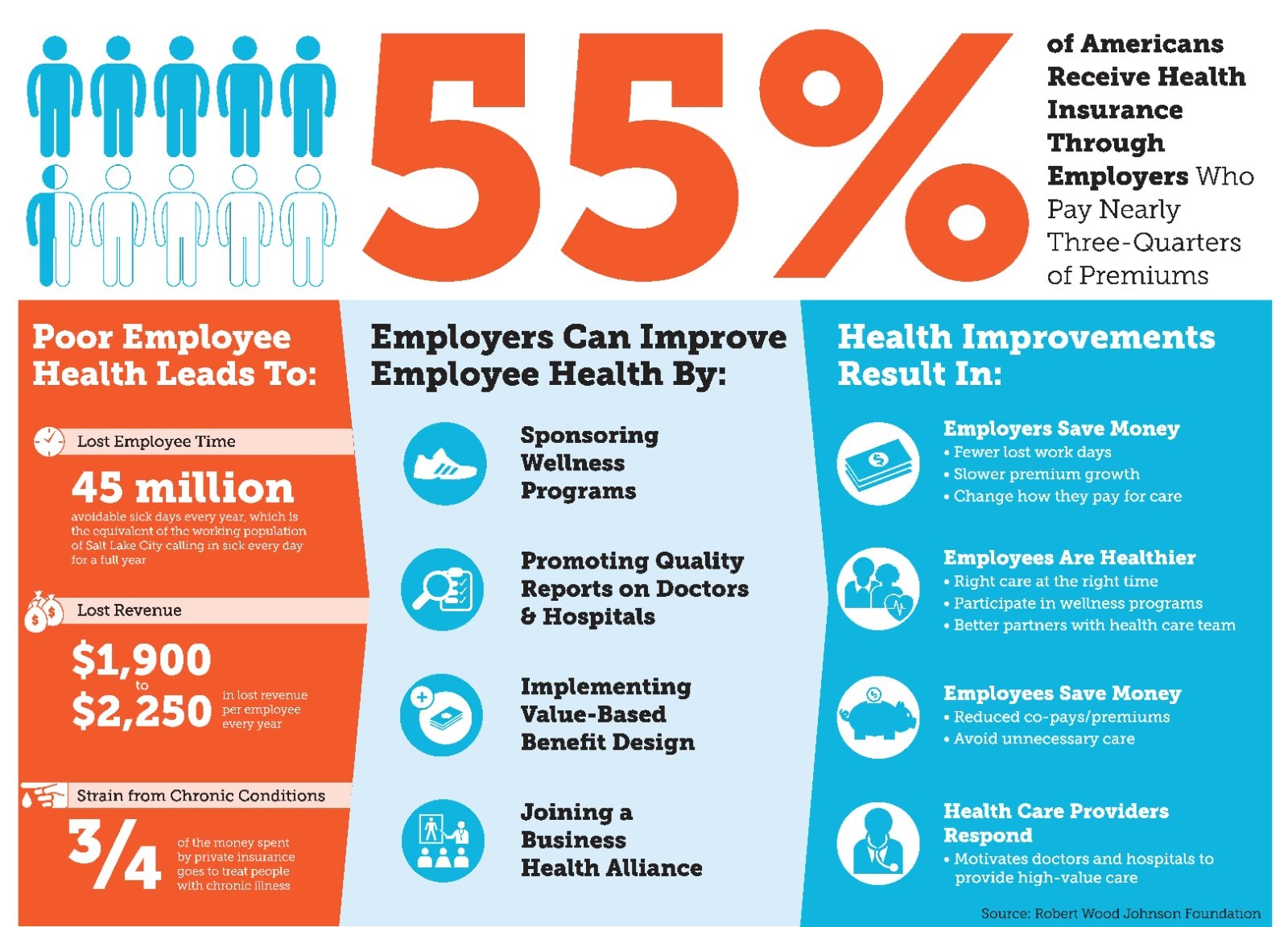How Does Employee Health Impact Your Business?
Employee health and wellness are critical aspects of a thriving workplace. Employers should care about their employees’ health and wellness for several reasons. Firstly, a healthy workforce is crucial for the success of any organization. Employees who are physically, mentally, and emotionally well are more likely to be engaged, productive, and satisfied with their jobs. Secondly, prioritizing employee health and well-being can help attract and retain top talent. In today’s competitive job market, job seekers are looking for employers that offer more than just a paycheck.
Comprehensive health benefits and a robust wellness program can differentiate a company from its competitors. Additionally, employers who care for employee health and well-being see numerous measurable benefits, from higher productivity and profitability to lower turnover and fewer safety incidents. Finally, investing in employee health can lead to reduced healthcare costs, as well as a more positive and supportive company culture.
Employee health and wellness are essential for the success of any organization. Employers who prioritize the health and well-being of their employees demonstrate a commitment to their staff and reap numerous benefits from doing so. From attracting top talent to improving productivity and reducing healthcare costs, there are many reasons why employers should care about their employees’ health and wellness.
The Benefits of Employee Health and Wellness
Employee health and wellness programs offer a wide range of benefits for both employees and employers. Here are some of the key benefits of implementing such programs:
- Improved Productivity: A healthy workforce is a more productive workforce. Employees who are physically and mentally well are better able to focus on their work and are less likely to be absent due to illness.
- Enhanced Employee Morale: When employers demonstrate a commitment to their employees’ health and well-being, it can have a positive impact on morale. Employees are more likely to feel valued and appreciated, leading to higher job satisfaction and lower turnover rates.
- Reduced Healthcare Costs: Wellness programs can help employees manage chronic conditions and prevent illness, leading to lower healthcare costs for both employees and employers.
- Improved Recruitment and Retention: A comprehensive wellness program can be a valuable differentiator for employers in a competitive job market. It can help attract top talent and retain existing employees who value health and wellness benefits.
- Alleviation of Stress: Wellness programs that include stress management resources can help employees better cope with the demands of their jobs, leading to lower stress levels and higher job satisfaction..
- Reduced Absenteeism: Employees who are healthy and well are less likely to miss work due to illness, leading to higher productivity and lower costs for employers.
- Enhanced Company Culture: A focus on employee health and wellness can contribute to a positive and supportive company culture, leading to higher employee satisfaction and loyalty.
- Improved Work-Life Balance: Wellness programs that offer flexible work arrangements and support for work-life balance can help employees better manage their personal and professional lives, leading to higher job satisfaction and lower turnover rates.

The Impact of Employee Health and Wellness on the Workplace
Employee health and wellness have a significant impact on the workplace, affecting various aspects such as absenteeism, presenteeism, and employee engagement. Here’s how employee health and wellness can impact the workplace:
- Absenteeism: Employee health and wellness programs can help reduce absenteeism by promoting healthy behaviors and providing access to preventive care. A healthy workforce is less likely to miss work due to illness, leading to higher productivity and lower costs for employers.
- Presenteeism: Presenteeism refers to employees being present at work but not fully productive due to health-related issues. Employee health and wellness programs can help alleviate presenteeism by providing resources for stress management, mental health support, and chronic disease management. When employees are physically and mentally well, they are more likely to be fully engaged and productive at work. Read more…
- Employee Engagement: Employee health and wellness programs can have a positive impact on employee engagement. When employers demonstrate a commitment to their employees’ health and well-being, it can lead to higher morale, job satisfaction, and overall engagement. Employees who feel supported in their health and wellness are more likely to be engaged at work and committed to the success of the organization.
Prioritizing employee health and wellness is crucial for creating a supportive and productive work environment. Employers can take several proactive steps to promote employee well-being. One
essential strategy is to lead by example, as business leaders who prioritize their own health and well-being can inspire employees to do the same. Additionally, offering programs and benefits to support
overall well-being, such as physical activity initiatives, stress management workshops, and nutrition education, can address various aspects of employee health. Involving employees in the design of
wellness programs can ensure that the initiatives meet their needs and interests.
Furthermore, providing incentives for wellness program participation, such as rewards or discounts on health insurance premiums, can encourage employee engagement. It’s also crucial to offer access to high-quality healthcare that meets employees’ needs, including preventive care and health assessments. Finally, monitoring and assessing the impact of wellness initiatives and continuously improving
and adapting them based on feedback and evolving needs is essential for long-term success in prioritizing employee health and wellness. By implementing these strategies, employers can create a work environment that fosters the well-being and success of their employees.
Case Studies
- Company X: Promoting a Culture of Well-being
Company X, a global technology firm, implemented a comprehensive wellness program that focused on holistic employee well-being. They created an inviting wellness center within their office premises, offering a range of services such as fitness classes, nutrition counseling, and stress management workshops. Additionally, they introduced flexible work arrangements, encouraging employees to maintain a healthy work-life balance. The wellness center at Company X became a hub of well-being, promoting physical, mental, and emotional health among employees. - TechCo’s Holistic Wellness Approach
TechCo, a leading technology company, recognized the importance of addressing the physical, mental, and emotional well-being of their employees. They implemented a holistic wellness program that encompassed various aspects of well-being, including regular exercise classes such as yoga, Pilates, and cardio workouts, along with workshops on mindfulness. This approach incentivized employees to prioritize their well-being and created a sense of friendly competition and camaraderie among the workforce. The company witnessed a significant increase in employee engagement, improved morale, and a decrease in lifestyle-related health issues. - Education Institution’s Employee Development and Wellness Integration
An education institution integrated employee development and wellness initiatives, promoting a culture of well-being and personal growth. They offered a range of wellness programs, including health challenges, financial wellness programs, and work-life balance initiatives. This integration led to improved employee satisfaction, reduced absenteeism, and a strengthened company culture. The institution recognized that investing in employee well-being was an investment in the success and longevity of the organization.
Employee health and wellness have a significant impact on a business. Providing health care benefits, such as health insurance, is essential for attracting and retaining employees. According to a report, 87% of employees value health benefits, and offering these benefits can lead to higher job satisfaction, fewer sick days, and a higher commitment to the organization’s goals. Employee health benefits typically include health insurance, paid time off, life insurance, dental coverage, vision coverage, and retirement benefits. By offering these benefits, employers can improve employee well-being, as employees who receive regular preventive care are likely to treat potential health issues early, minimizing out-of-pocket expenses. Overall, prioritizing employee health and wellness is crucial for creating a positive work environment and maintaining a productive workforce.
Schedule a 15-30-minute meeting or with us with no obligation today to find out how! If you want to create a challenge or a bundle of challenges, we can get you set up in one call!
